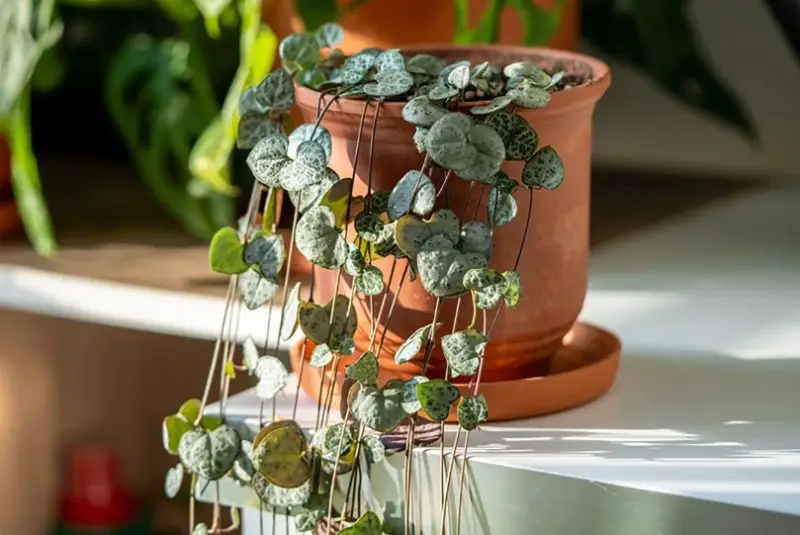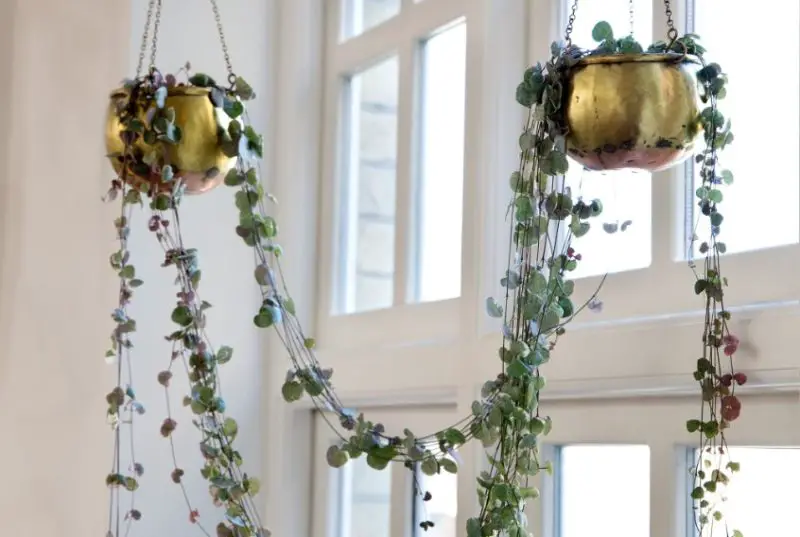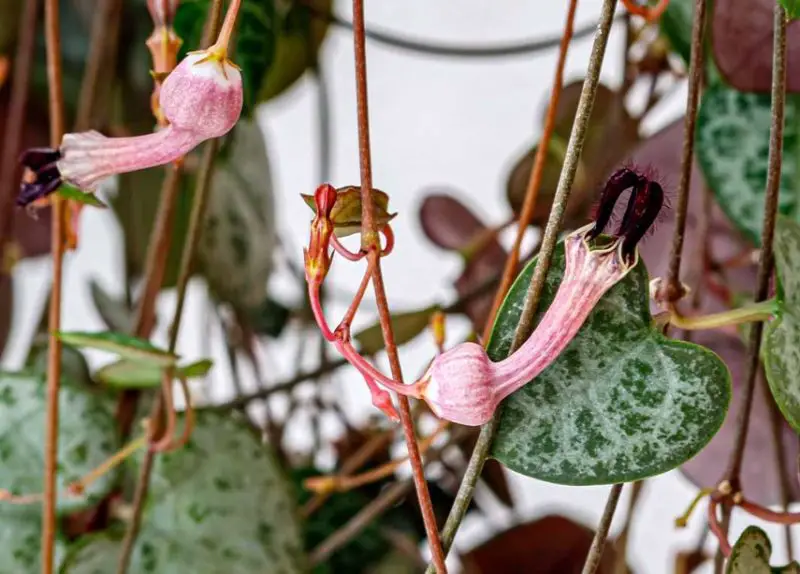The String of Hearts (Ceropegia woodii) is a popular trailing houseplant known for its delicate, heart-shaped leaves and elegant vines. Despite its dainty appearance, this succulent is remarkably resilient and easy to care for, making it a favorite among both novice and experienced plant enthusiasts.
Whether you’re looking to add a touch of greenery to your home or enhance your indoor garden with its unique charm, understanding the specific needs of the String of Hearts is crucial for maintaining its health and beauty. This detailed care guide will provide you with essential tips on light, water, soil, and more to help your String of Hearts thrive.
String of Hearts Overview

The String of Hearts (Ceropegia woodii), also known as the rosary vine, chain of hearts, or Chinese lantern, is a stunning succulent vine belonging to the Apocynaceae family. Native to Africa, this plant is cherished for its delicate, heart-shaped leaves that create a charming, trailing effect. Typically, it reaches a mature height of 1-2 inches with a spread of up to 1.5 inches. It thrives in partial sunlight, making it perfect for indoor spaces where it can receive bright, indirect light. The ideal soil for this plant is well-drained with an acidic to neutral pH, ensuring optimal growth and health.
Blooming from summer to fall, the String of Hearts produces small, lantern-like flowers that vary in color from white to red, adding a delightful pop of color to its cascading foliage. This plant is suited for USDA hardiness zones 9-12 and prefers warm temperatures, thriving best between 60-85°F. It’s essential to allow the soil to dry out completely between waterings to prevent root rot, a common issue for succulents. With its enchanting appearance and relatively easy care requirements, the String of Hearts makes a wonderful addition to any indoor plant collection or mixed succulent arrangement.
String of Hearts Care and Growing Guide
If given the proper temperature, humidity, and filtered light, the string of hearts plant can develop quickly and produce a large number of flowers. It has a reputation for being hardy and is a suitable choice for novice indoor plant growers because it can tolerate periods of neglect really well.

Light
To ensure your String of Hearts plant thrives and produces an abundance of flowers, it is essential to place it in a location where it receives bright but dappled, filtered sunlight. This type of lighting is ideal, as it allows the plant to photosynthesize efficiently without the risk of scorching its delicate leaves.
Direct sunlight can be too intense, potentially causing the leaves to burn, while insufficient light can lead to leggy growth and reduced flowering. An optimal spot might be near a window with sheer curtains that diffuse the sunlight, providing the perfect balance of brightness without direct exposure. Alternatively, you can position the plant under a canopy or shade that mimics the natural dappled light conditions found in its native habitat. Regularly rotating the plant ensures even light exposure on all sides, preventing asymmetrical growth.
Soil
String of Hearts plants thrive in well-drained cacti potting mixes. These plants require a soil environment that allows water to drain quickly, preventing root rot and other moisture-related issues. While they do appreciate a certain level of fertility, overly rich soil can cause the plants to become straggly and less attractive. The ideal soil mix should balance nutrition with excellent drainage to support healthy growth and robust foliage.
If you are using an ordinary potting mix, it is essential to enhance it with additions like pumice or perlite to ensure adequate drainage. These amendments help create air pockets in the soil, allowing excess water to escape and roots to breathe. Perlite is particularly effective in improving aeration and drainage without adding too much weight to the pot. Pumice also provides similar benefits, making the soil lighter and more porous.
To create the perfect soil blend, mix standard potting soil with equal parts perlite or pumice. This combination will help maintain the right moisture levels and prevent the soil from becoming compacted.
Water
The String of Hearts, despite its drought tolerance, requires more frequent watering compared to many other succulent species. While it can survive periods of drought, overwatering can lead to issues such as swollen foliage, leaf drop, and a messy growth habit. To maintain its health and appearance, it’s crucial to follow proper watering practices.
Allow the soil to dry out completely between waterings. This ensures that the roots do not sit in waterlogged soil, which can cause root rot and other fungal diseases. When watering, provide a deep soak, allowing the water to penetrate deeply into the soil.
Avoid leaving your String of Hearts plant standing in water, as this can quickly lead to root suffocation and plant death. Excellent drainage is essential to prevent water from pooling at the bottom of the pot. Ensure that your pot has drainage holes and that excess water can freely escape.
During the growing season, typically spring and summer, when the plant is actively growing, you may need to water more frequently. In contrast, during the winter months or periods of dormancy, reduce the frequency of watering to prevent waterlogged conditions.
Temperature and Humidity
String of Hearts plants are resilient to a range of temperatures, tolerating lows as low as 20 degrees Fahrenheit for brief periods. However, prolonged exposure to cold can be detrimental, especially if the plant hasn’t retained enough moisture. It’s essential to protect them from frost and extreme cold by bringing them indoors during harsh winter conditions or providing adequate frost protection.
While these plants can withstand cooler temperatures, they are not fond of intense heat. High temperatures, especially coupled with high humidity during their winter dormancy phase, can adversely affect their health. To ensure optimal growth and health, aim for moderate temperatures and good air circulation.
During the active growing season in spring and summer, String of Hearts plants thrive in warm temperatures ranging between 60-85 degrees Fahrenheit. In cooler months or during dormancy, they may benefit from slightly cooler temperatures but should still be kept away from drafts or excessively cold spots.
Maintaining suitable temperature and humidity levels helps promote vigorous growth and prevent stress-related issues like leaf drop or stunted growth.
Fertilizer
To ensure your String of Hearts plant thrives and maintains its lush appearance, regular fertilization with a suitable succulent fertilizer is beneficial. Choose a fertilizer specifically formulated for succulents and cacti, as these contain the right balance of nutrients to support healthy growth without overstimulating excessive foliage growth.
When applying fertilizer, it’s crucial to follow the product label instructions regarding dosage and frequency. Typically, fertilize your String of Hearts plant during the active growing season in spring and summer. Reduce or suspend fertilization during the fall and winter months, when growth naturally slows down.
Avoid using fertilizers high in nitrogen, as this can promote rapid, soft growth that may make the plant more susceptible to damage and disease. Instead, opt for a balanced or slightly higher phosphorus (P) and potassium (K) ratio to encourage flowering and overall plant health.
Apply the fertilizer to damp soil and avoid direct contact with the plant’s foliage to prevent potential burns. After fertilizing, water the plant lightly to help distribute the nutrients evenly throughout the root zone.
Pruning
Pruning String of Hearts plants is not essential but can be beneficial for managing their growth and appearance. If your plant becomes too long or starts to look unruly, pruning can help maintain its shape and promote bushier growth.
When pruning, cut the stems just below a node where a set of leaves grows. This encourages new growth from the trimmed stem and helps prevent bare, leggy sections. String of Hearts plants are resilient and can tolerate hard pruning, so you can trim them back as much as needed to achieve the desired size and shape.
Regular pruning also rejuvenates the plant, removing old or damaged growth and stimulating fresh growth. Use clean, sharp scissors or pruning shears to make precise cuts and minimize damage to the plant.
After pruning, you can propagate the cuttings to propagate new plants. Allow the cut ends to callous over for a day or two before planting them in well-draining soil.
Common Pests & Plant Diseases
String of Hearts plants are susceptible to several common pests, including mealybugs, aphids, and scale insects. These sap-sucking pests can cause the plant to wilt and look unhealthy if left untreated. Mealybugs appear as white, cottony clusters, while aphids are small, soft-bodied insects often found on new growth. Scale insects can be identified by their armored shells attached to stems and leaves.
To combat these pests, use insecticidal soap or neem oil, which effectively suffocate and kill them. Alternatively, a strong stream of water can dislodge aphids from the plant.
In addition to pests, String of Hearts plants are prone to fungal infections such as mold and root rot. An insect infestation can create conditions favorable for mold growth, as pests leave behind a sticky residue that promotes fungal development.
To prevent fungal issues, ensure good air circulation around the plant and avoid overwatering. Place the plant in well-draining soil and in a warm, bright location where excess moisture can evaporate quickly. This helps the plant use water efficiently and reduces the risk of root rot, which can damage the plant’s roots and cause wilting and decline. Regular inspection for pests and diseases allows for early detection and effective treatment, preserving the health and beauty of your String of Hearts plant.
Overwintering
During the winter, String of Hearts plants thrive best in temperatures ranging from 60 to 80 degrees Fahrenheit. They are sensitive to cold and can perish if exposed to temperatures below 40°F. As the plant enters dormancy in winter, reduce watering and allow the soil to dry out between waterings to prevent root rot.
To successfully overwinter your String of Hearts, gradually acclimate it to cooler temperatures and reduced watering in late fall. Place the plant in a cooler spot with indirect light. In spring, as temperatures begin to warm, gradually reintroduce the plant to brighter conditions and resume regular watering. This gradual transition helps the plant adjust and minimize stress, ensuring it emerges from dormancy healthy and ready to resume active growth.
Types of String of Heart Plants
There are several types of String of Hearts plants, each with distinct characteristics. Ceropegia woodii variegata features green leaves with cream, pink, and silver markings. Ceropegia woodii ‘Heartless’, also known as string of spades or Mini Star, has bright green leaves with pink undersides. Ceropegia woodii ‘Silver Glory’ stands out with apple-shaped leaves displaying silver variegation and a dark green line. Ceropegia woodii ‘Orange River’ has green leaves tinged with orange. Ceropegia linearis, or string of needles, has foliage resembling tiny needles. Each variety offers a unique aesthetic, contributing to the diversity and appeal of String of Hearts plants among succulent enthusiasts.
How to Make String of Hearts to Bloom

The String of Hearts vine may disappoint if you are a fan of large, eye-catching blossoms because it only produces modest, tiny blooms. Its blossoms are fascinating, though. They have an inch or so of tubular shape and a bulbous base that forms beads, giving rise to one of their common names, the rosary vine.
While they can bloom at other times of the year, the pale pink flowers typically open in late summer and early fall. Outside, they blossom quickly, but rarely inside. Maintaining the plant’s health, giving it plenty of bright, indirect light, and fertilizing it once a month in the spring and summer will improve the likelihood that it will blossom. Maintaining these circumstances will aid with the production of your String of Hearts’ distinctive and endearing blossoms.
Frequent Issues with String of Hearts
String of Hearts is typically hassle-free but can encounter issues like yellowing, curling, or dropping leaves.
Yellowing leaves often result from overwatering or cool temperatures below 60°F, which cause dormancy. Reduce watering and ensure the soil is dry an inch below the surface.
Dropping leaves can also indicate overwatering or a lack of sunlight. Improve soil drainage with pebbles or perlite, and consider using clay or terra-cotta pots.
Curling leaves usually signal underwatering. Establish a regular watering routine and gradually rehydrate severely dry plants to avoid shock.
Proper care ensures the health and vitality of your String of Hearts.






